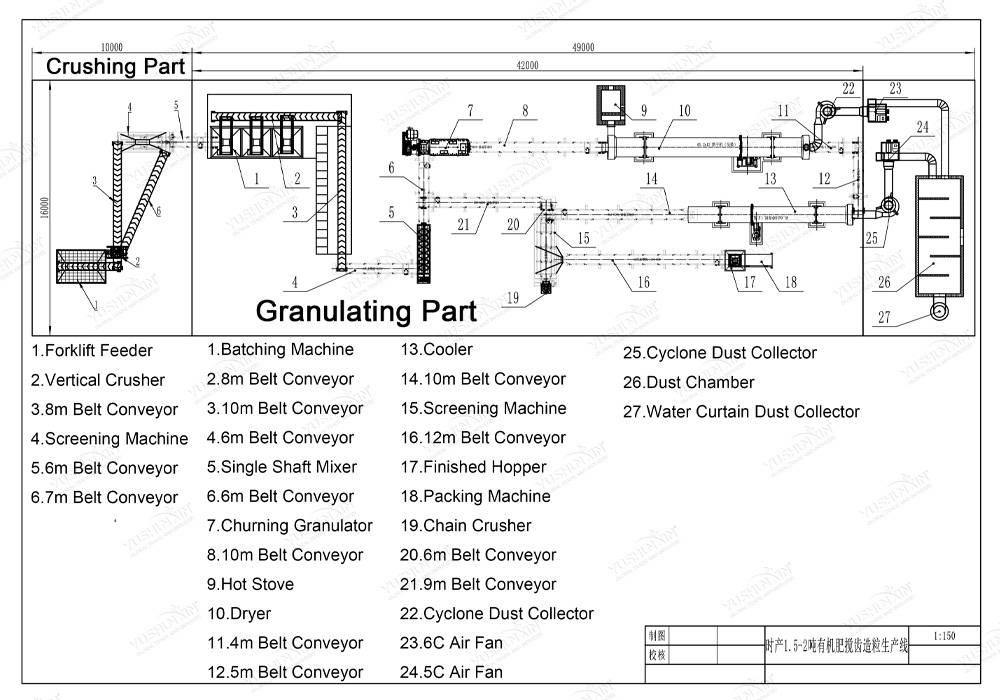









Common Organic Fertilizer Raw Materials
1. Livestock Manure
– Chicken Manure: High nitrogen content, fast acting, but needs to be fully decomposed to avoid burning plants.
– Pig Manure: Balanced in organic matter and nutrients, commonly used as an organic fertilizer material.
– Cow Manure: High fiber content, decomposes slowly, suitable for mixing with high-nitrogen materials.
– Sheep Manure: High nutrient content, with a moderate fertilizing effect.
2. Industrial By-products
– Brewer’s Spent Grain: The residue left after brewing, rich in organic matter and nitrogen.
– Sugar Factory Residues: Such as bagasse and beet pulp, high in carbon content.
– Food Processing Waste: Includes by-products like soy pulp, fruit pulp, starch residue, etc., easy to degrade and nutrient-rich.
3. Agricultural Waste
– Crop Straw: Such as corn, wheat, rice straw, etc., rich in cellulose and organic matter.
– Fruit Shells and Pulp: Such as peanut shells, coconut shells, sugarcane residue, etc., high carbon-to-nitrogen ratio, suitable for adjusting the carbon-nitrogen ratio in composting.
– Waste Vegetables and Fruits: Such as spoiled vegetable leaves, fruit peels, etc., easy to degrade, but care should be taken with the high moisture content.
4. Urban Organic Waste
– Kitchen Waste: Rich in organic matter and nutrients, but should be separated from oils and impurities.
– Sludge: Sewage treatment plant sludge, must be free of heavy metal contamination.
– Garden Waste: Such as fallen leaves, pruned tree branches, etc., high in carbon content.
5. Other Raw Materials
– Mushroom Residue: The waste substrate after mushroom cultivation, rich in organic matter.
– Oilseed Cakes: Such as soybean cake, rapeseed cake, etc., high in nitrogen, making them high-quality organic fertilizer raw materials.
– Seaweed: Rich in minerals and growth hormones, suitable for producing high-end organic fertilizers.
Raw Material Proportion Principles
1. Carbon-to-Nitrogen Ratio (C/N) Adjustment
– The ideal carbon-to-nitrogen ratio is 25:1~30:1.
– High-carbon materials (e.g., straw, wood chips) should be mixed with high-nitrogen materials (e.g., livestock manure, soybean cake) to balance the C/N ratio.
2. Moisture Control
– The moisture content of the materials should be controlled between 50% and 60%. Too high or too low moisture will affect the fermentation process.
3. PH Adjustment
– During fermentation, the pH should be maintained between 6.5 and 8.5. Lime or acidic substances can be added to adjust the pH.
4. Addition of Fermentation Microorganisms
– Adding microbial agents (such as *Bacillus subtilis*, *Actinomycetes*, etc.) can accelerate the fermentation process and improve the composting efficiency.
Environmental Friendliness
Energy Efficiency
Automated Control
Customizable Fertilizer Formulations
High-Quality Granulation
Moisture Control
Low Pollution and Odor Control
Flexible Capacity
High Efficiency and Yield
Minimal Labor Requirements
Advanced Drying and Cooling Systems
Sustainability
The cost of each production line varies depending on production capacity, degree of automation, and specific needs. Fill in the form below and we will provide you with an accurate quote!
If you're interested in our fertilizer making equipment, please submit your requirements and contacts and then we will contact you in two days. We promise that all your information won't be leaked to anyone.
- The company was founded in 2005 and has been focusing on the research and development and manufacturing of organic fertilizer equipment for 20 years. It has built a 40,000m large-scale organic fertilizer equipment production base, using advanced granulation, drying and screening technologies to improve production efficiency and product quality.
- A self-operated import and export enterprise with more than 80 professional engineers worldwide, serving more than 100 countries and regions around the world, 5,000+ customer service cases, 10 processing centers, 3 laser cutting machines, and more than 60 equipment of various types.
- Maintaining long-term and extensive cooperation with many scientific research institutes and universities, with a professional R&D team, it can continuously optimize equipment performance according to market demand.
- High-strength wear-resistant materials, carbon steel Q235/Alloy are selected to ensure that the equipment is durable and reduce maintenance costs.
- Adopting intelligent control systems to improve the level of production automation and reduce manual dependence.
- ISO, CE, SGS international certification
- With large-scale production capacity, it can meet different production capacity requirements (small, medium and large production lines).
- A full range of equipment models, suitable for the production of various types of fertilizers such as organic fertilizer, compound fertilizer, biological fertilizer, water-soluble fertilizer, liquid fertilizer, etc.
- Personalized design can be provided according to customer needs, including production capacity, site layout, environmental protection standards, etc.
- Provide a complete set of production line solutions, including equipment selection, installation and commissioning, technical training, etc.

- Direct factory supply, reducing the middleman link, and the price is more competitive.
- The equipment has high energy efficiency, reduces energy consumption, and helps customers reduce long-term operating costs.
- Direct factory supply, reducing the middleman link, and the price is more competitive.
- The equipment has high energy efficiency, reduces energy consumption, and helps customers reduce long-term operating costs.
Ecuadorian Customers Highly Praise the Wastewater Dewatering Machine
Vietnam Customer’s High Praise for the Potassium Fertilizer Production Line
The Mexican Fertilizer Line Was Successfully Installed
Our fertilizer production equipment has been successfully delivered to Australia without any damage.